
Forty Years ago in the X-15 Flight Test Program, August - October 1960 |
Following Robert White's speed record setting flight on August 12, 1960, Joe Walker made his third flight in the X-15-1 on August 19. Walker's first attempt to make the flight was aborted the previous day because of problems with the Auxiliary Power Unit. Jack Allavie and Frank Cole were at the controls of the NB-52A.
The flight was a near repeat of Walker's previous flight. Walker was launched over Silver Lake, just a few miles north of the town of Baker, California, that place with the big thermometer that you pass on the way to Vegas. His top speed was Mach 3.13 (1,986 miles per hour) and his maximum altitude was 75,982 feet.
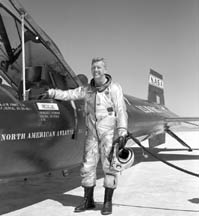 NASA pilot Joe
Walker. Photo E-6682 Courtesy NASA Dryden.
NASA pilot Joe
Walker. Photo E-6682 Courtesy NASA Dryden.
The X-15-2 was trucked to North American Aviation in El Segundo for the installation of its XLR-99 rocket engine in early September 1960. It returned to Edwards AFB with the new powerplant later that month.
The X-15-1 made two flights in September 1960 and two flights in October 1960. Major Robert White was scheduled for launch on his fifth X-15 flight on September 2, but the flight was cancelled by bad weather before the NB-52B got off the ground. Problems with the Stability Augmentation System resulted in the cancellation of the next attempt scheduled for September 9.
On September 10, Jack Allavie and Charles Kuyk piloted the NB-52B to Silver Lake to launch White on his first Mach-3 flight. The flight profile was very similar to Joe Walker's last two flights. White reached Mach 3.23 (2,182 miles per hour) and 79,864 feet altitude.
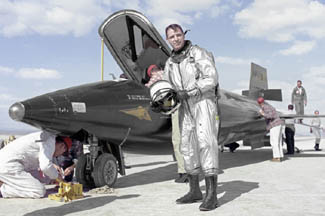 Air
Force Captain Robert White. Photo ECN-101 Courtesy NASA Dryden.
Air
Force Captain Robert White. Photo ECN-101 Courtesy NASA Dryden.
The X-15 program entered a phase of pilot check-outs. Four new pilots were introduced to the X-15 in the closing months of 1960. Their familiarization flights were planned to stay in the vicinity of Edwards Air Force Base. The typical maximum speed planned for the familiarization flights was Mach-2 and the maximum altitude was approximately 50,000 feet.
Navy Commander Forrest Petersen became the fourth X-15 pilot in September 1960. Mission 1-A-24, the first attempt to launch Commander Petersen was aborted before launch on September 20.
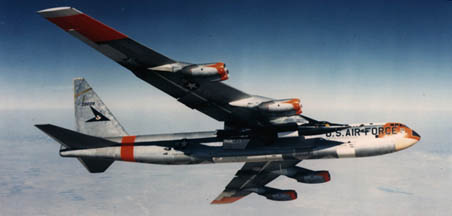 NB-52B carries the Commander Petersen on his
first X-15 launch attempt on September 20, 1960. The DayGlo
orange paint was stripped from the vertical stabilizer and a
DayGlo band was painted around the rear fuselage during the
summer of 1960. The DayGlo remains on the engine nacelles. The
DayGlo would be removed from the engine nacelles by the end of
October. Notice that the bomb bay doors are painted white. The
outboard ailerons are also painted white. Photo courtesy Terry
Panopolis.
NB-52B carries the Commander Petersen on his
first X-15 launch attempt on September 20, 1960. The DayGlo
orange paint was stripped from the vertical stabilizer and a
DayGlo band was painted around the rear fuselage during the
summer of 1960. The DayGlo remains on the engine nacelles. The
DayGlo would be removed from the engine nacelles by the end of
October. Notice that the bomb bay doors are painted white. The
outboard ailerons are also painted white. Photo courtesy Terry
Panopolis.
Jack Allavie and Fitzhugh Fulton launched Commander Petersen from the NB-52B near Palmdale, southwest of Edwards Air Force Base on September 23. Petersen's pointed the X-15-1 toward the town of Boron. At Boron, his flight plan called for him to make a left turn toward the town of Mojave and then another left turn to return to Edwards Air Force Base.
The XLR-11 engines shut down when Petersen had reached only Mach 1.68 (1,108 miles per hour). He was turning left over Boron when he lost power. The flight path for his familiarization flight had been selected to keep him positioned for a return to the lakebed in the event of just such an emergency. He continued the turn to reach the high key position for runway 18 on Roger Dry Lake with Joe Walker in the chase plane tucked in close beside the X-15.
Petersen reached the high key position at 25,000 feet altitude, which was lower than the desired altitude. Walker urged him to tighten up his turn as they made a left 360-degree turn. Petersen actually arrived on final approach a little high on energy. He popped the speed brakes to set the X-15 down at the correct position on the runway. The Dryden Diary entry for this flight says, "Exciting but good".
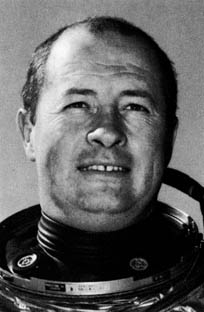 Navy Commander Forrest Petersen
Navy Commander Forrest Petersen
Commander Petersen's next flight was scheduled for October 11, but a loss of Nitrogen source pressure caused the launch to be scrubbed.
The first flight of the X-15-2 with the XLR-99 engine was scheduled for October 12, 1960, but the first big engine mission was postponed by "structural difficulty." On October 13, Scott Crossfield suited up and climbed into the cockpit of the X-15-2 under the wing of the NB-52A, but the right hand auxiliary power unit developed a leak and the mission was scrubbed.
Fitzhugh Fulton and Charles Kuyk launched Commander Petersen on his second X-15 flight on October 20. The flight plan for this flight was a repeat of the plan for his first flight. After turning west toward Mojave, he accelerated the X-15-1 to Mach 1.94 (1,280 miles per hour), climbing to a maximum altitude of 53,800 feet.
Eight days later, on October 28, Fitzhugh Fulton and Frank Cole launched Jack McKay on his first X-15 flight from the NB-52B. He made the usual circuit from Palmdale to Boron, Mojave, and back to Edwards Air Force Base. He reached Mach 2.02 (1,333 miles per hour) and 50,700 feet. The Dryden Diary notation for this flight is "Pretty - Pretty".
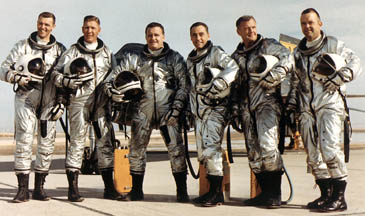 NASA pilot Jack Mckay is third from the left.
Photo EC66-1017 courtesy NASA Dryden.
NASA pilot Jack Mckay is third from the left.
Photo EC66-1017 courtesy NASA Dryden.
*The first position of the mission number identifies which X-15 was involved, the second number indicates how many times that X-15 had been launched, and the third number indicates how many times it had been carried by an NB-52.
Send a message to Brian
Go to home page of the Goleta Air & Space Museum.
Edited September 12, 2000.